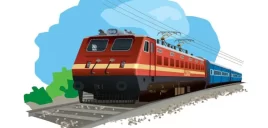There are several diesel-electric multiple units (DEMUs) and diesel-hydraulic multiple units (DHMUs) in operation. Most are made by ICF. The BG DEMUs have a Cummins VTA 1710 V-12 prime mover of 705 HP, whereas the BG DHMUs have two 350hp underfloor engines (Cummins 855R) driving two separate Voith hydraulic transmissions via propeller shafts and differentials. These have a rated maximum speed of about 105km/h. The first units were introduced in 1993-94.
[2/01] A newer variant of the DEMU from ICF has been spotted on the Ahmedabad – Abu Road section with two underslung Cummins NT 855R engines each driving a traction alternator whose output is fed to 4 traction motors.
[7/04] A new aerodynamically shaped DEMU model from ICF has been brought into service on the SCR (Bhimavaram – Narsapur – Vijayawada). The leading driving motor cars of these 8-car rakes have a distinctive appearance with a large sloping oval windshield in one piece and can accommodate 54 passengers; the rear motor car accommodates 72. The other six trailer cars of a rake accommodate 84 seated passengers and 240 standing passengers each. A slightly modified version has been brought into service [5/05] for the Shalimar-Digha section.
The MG versions of the DEMU come from RCF. The first rake was commissioned in March 2003 and another is scheduled to be commissioned in 2003. The formation has 6 coaches including two driver cars and four trailer coaches, with a total carrying capacity of over 1000 passengers (with seating for 424). Max. speed is 75km/h.
The MG DEMU has a Cummins NT 855 inline 4-cylinder engine developing about 400hp, with a BHEL traction alternator. They are slated for use on the Indore-Mhow section of WR, and have been recently [2/03] tested on the Delhi – Sarai Rohilla section. Two units are in use [12/06] on the Indore-Mhow section. MG DEMUs are also in use on WR’s Mahesana-Taranga hill section [2/11].
Historical note: The RCF rakes are not the first MG diesel multiple units. Fiat supplied some for the Chennai area in 1955. These were diesel-hydraulic units (confirmation needed).
Driving cars with power are classifed “DPC” (driving power car). Non-engine driving coaches with cabs are classifed “DTC”. Trailer coaches are classified “TC”.
High-Power DMU (High Horsepower DMU): Newer DMU models (the High Powered DMU or HPDMU units, with a 1400hp V-16 engine (Cummins KV-16)) were introduced in 1999 by ICF and are now in regular use at several places. The HPDMUs are coupled in 4-car units (one power car + three trailer cars) as opposed to the 3-car rakes (power car + two trailer cars) for the lower-powered DMUs, and have pneumatic secondary suspension. Acceleration is improved, at 0.54m/s2. A 4-car unit carries 1092 passengers.
The HPDMUs were used around Bangalore at first, and some suburban services around Chennai (Beach – Kanchipuram). Some sections on NR have also been considered. The first HPDMU units underwent trials at Whitefield near Bangalore in 2000. One HPDMU rake was later [9/00] in trial operation between Madras and Sulurpet, while another could be seen running in trials between Madras and Arakkonam. Note: Sometimes these are referred to by the acronyms HHPDMU or HHPDEMU (” High Horse-power DMU/DEMU”). The max. speed for most of these DMU/DEMU/DHMU vehicles is 105km/h.
The HPDMUs have been seen with road numbers in the 14xxx and 15xxx ranges. SCR’s new aerodynamic DEMU coaches have 150xx numbers for power cars and 154xx for trailer cars [4/05].
DMU and DHMU services are seen in places such as Secunderabad, Ahmedabad – Abu Road, Lonavala-Pune-Daund, etc. DHMU services on Konkan Railway began in 1997 with a Karwar-Pernem service which was later extended to Ratnagiri. It now [4/01] runs on the Karwar-Madgaon section.
DEMUs are homed at Madgaon, Abu Road, Daund, Shoranur, and Satna, in addition to a sizeable fleet (23?) homed at Jallundhar. Sections worked by these diesel multiple units include Daund-Pune, Tiruchirapalli-Karur, Patna-Rajgir, Anand-Khambat (BG), Vijayawada-Bhimavaram-Narsapur (BG), Delhi-Shamli (BG), Mehasana-Tarangahill (MG), Ahmedabad – Mehsana / Abu Road, Madras Beach / Egmore – Kanchipuram, etc.
In the Bombay suburban area, DMUs used to work the Virar – Dahanu Road section extensively, but now [2/11] only one Diva-Boisar service remains; the DMUs were/are homed at the Bandra Marshalling Yard. The rake formation for these usually has the power car in the middle of the rake. DMUs are also found around Hyderabad, on the Secunderabad-Bolarum, Secunderabad-Medchal routes.
[12/99] More: DMUs also ply on the Dombivli-Vasai-Diva route, and in the Lucknow suburban area. [3/01] New services: Kharagpur-Jaleshwar-Bhubaneshwar, Jalandhar-Hoshiarpur, Kotkapura-Fazilka, Samastipur-Darbhanga.
Other diesel units: Several self-propelled Medical Relief Trains (MRT’s) are also in use; these use two Cummins 375hp underfloor diesel engines and are thus rather like DMUs although of course they are used for accident relief operations and not passenger services. The transmission is hydraulic. An MRT has one coach with medical facilities and one driving car with the engines. These MRTs are made by RCF. ICF also plans to make 3-car accident relief / medical relief rakes.
DMU Formations
The DMUs are often seen in 3-car units, with one DPC, one TC, and one DTC each. Where the traffic is higher, DEMU and DHMU formations usually consist of 6 (as at Secunderabad), sometimes 9, cars (with 2 power cars, one at either end). Ahmedabad – Abu Road DMU formations regularly have 9 cars, recently [8/00] upgraded to 12 cars, although 6-car formations are also seen.
In sections such as Lonavala-Pune-Daund, the traffic is high enough that 9-car and 12-car formations have been considered. Madgaon has 2-car and 3-car DMUs (power cars at either end), but most DMU rakes have 3-car units, leading to 6-, 9-, and 12-car formations. Diva – Roha trains and KR passenger trains often have a diesel loco (WDM-2) at the head and a DMU in the middle of the rake. (Diva-Vasai trains have a regular loco, and not a DMU, in the middle.)
HPDMU rakes (currently [8/00] being tested at Whitefield near Bangalore) have four cars, making it likely that 8-car and 12-car formations will be common for HPDMU services, although 16-car formations have been tried experimentally. Arakkonam-Jolarpettai MEMU rakes are formed with two driving motorcoaches (one at either end) and six trailer coaches in the middle.
Source – IFRCA.org
Disclaimer: The Information /News /Video provided in this Platform has been collected from different sources. We Believe that “Knowledge Is Power” and our aim is to create general awareness among people and make them powerful through easily accessible Information. NOTE: We do not take any responsibility of authenticity of Information/News/Videos.
This entry was posted in 2 Railway Employee, STUDY NEW, Railway Employee











